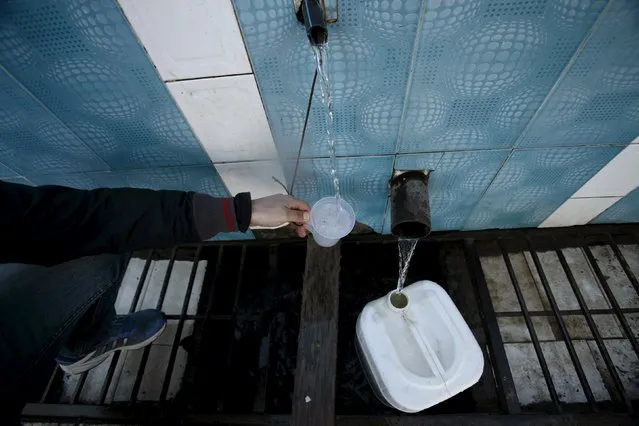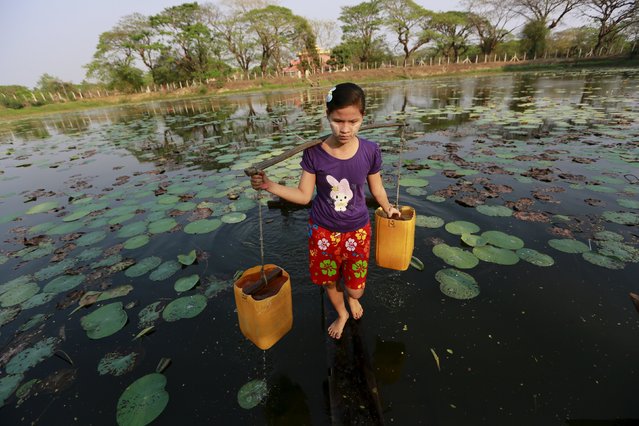
Men collect water from the Euphrates river in Najaf, south of Baghdad, Iraq March 7, 2016. Some 650 million people, or one in 10 of the world's population, have no access to safe water, putting them at risk of infectious diseases and premature death. Dirty water and poor sanitation can cause severe diarrhoeal diseases in children, killing 900 under-five a day across the world, according to United Nations estimates. The U.N. says access to safe drinking water and adequate sanitation services is vital to human health. It is also important for other reasons – ranging from easily identifiable and quantifiable benefits such as cost and time savings, to more intangible factors like convenience, well-being, dignity, privacy and safety. The WHO estimates that every $1 invested in improving water supply and sanitation services yields gains of $4 to $12, depending on the type of intervention. World Water Day, marked this year on March 22, highlights various concerns about the world's water resources, and in 2016 is focusing on how good access to safe water can create paid work and contribute to a greener economy. (Photo by Alaa Al-Marjani/Reuters)

A girl fills buckets with water at al-Nour camp for internally displaced people in Jerjnaz town, in Idlib province, Syria March 7, 2016. (Photo by Khalil Ashawi/Reuters)

Boys collect water from a swamp in northeast Baghdad, Iraq March 7, 2016. (Photo by Ahmed Saad/Reuters)

A boy fills plastic bottles with drinking water from a tap on the outskirts of Islamabad, Pakistan February 22, 2016. (Photo by Faisal Mahmood/Reuters)

A resident living in a flooded area refills plastic containers with drinking water on an improvised “banca” (small boat) in Artex compound, Malabon city, north of Manila, Philippines March 4, 2016. (Photo by Romeo Ranoco/Reuters)

Ram Kumar Khadka, 36, climbs out of a well after cleaning it in Kathmandu, Nepal February 22, 2016. Khadka has worked as a cleaner for 12 years and earns around $18 a day. (Photo by Navesh Chitrakar/Reuters)

Men pour water brought by cart into a container at a stall on Clifton Beach in Karachi, Pakistan March 5, 2016. (Photo by Akhtar Soomro/Reuters)

Children drink water from a public water pump on the outskirts of Kabul, Afghanistan March 4, 2016. (Photo by Omar Sobhani/Reuters)

A boy draws drinking water from a well using a hand pump in Peshawar, Pakistan March 4, 2016. (Photo by Fayaz Aziz/Reuters)

A woman fills a bucket with drinking water from a well in the village of Rum, Belarus March 4, 2016. (Photo by Vasily Fedosenko/Reuters)

An employee at a boat station drills a hole in the frozen surface of the Yenisei River to draw fresh water for cooking and drinking, outside Krasnoyarsk, Siberia, Russia March 2, 2016. (Photo by Ilya Naymushin/Reuters)

A man carries buckets filled with water on the banks of the river Ganges in Allahabad, India March 4, 2016. (Photo by Jitendra Prakash/Reuters)

People refill bottles at a water store in Temple City, California, United States March 4, 2016. (Photo by Mario Anzuoni/Reuters)

A water bottle is seen next to a student studying at the University of California Los Angeles (UCLA) campus in Los Angeles, California, March 4, 2016. (Photo by Lucy Nicholson/Reuters)

A source of water and a statue of Our Lady of Aparecida, Brazil's national saint, are seen inside a cave in Sao Francisco Xavier, Sao Paulo state, Brazil March 3, 2016. (Photo by Nacho Doce/Reuters)

A woman drinks water in El Crucero town, Nicaragua February 27, 2016. (Photo by Oswaldo Rivas/Reuters)

A woman and her granddaughter are seen next to a rainwater tank (R) that collects water used for washing and cleaning in San Miguel Xicalco, on the outskirts of Mexico City, Mexico March 4, 2016. (Photo by Henry Romero/Reuters)

A man places his bottles to be filled with water dripping from a spring next to a highway along the Avila mountain in Caracas, Venezuela March 3, 2016. (Photo by Carlos Garcia Rawlins/Reuters)

People fetch water in containers in canoes at a water selling point in the Makoko fishing community on the Lagos Lagoon, Nigeria February 29, 2016. (Photo by Akintunde Akinleye/Reuters)

A civil defence worker pours water from a water truck into a container near a dry lake in Presidente Figueiredo, in Amazonas state, Brazil March 4, 2016. (Photo by Bruno Kelly/Reuters)

A woman carries jerrycans to fill them with water from a charity tap in Yemen's capital Sanaa, March 7, 2016. (Photo by Khaled Abdullah/Reuters)

A man fills a glass with water from a spring in Chiffa in Medea Governorate, Algeria March 4, 2016. (Photo by Ramzi Boudina/Reuters)

An indigenous Sahrawi woman fills a jerrycan with water from a cistern outside her shelter at a desert refugee camp of Al-Smara in Tindouf, southern Algeria March 2, 2016. (Photo by Zohra Bensemra/Reuters)

Residents walk past water pipes in the rebel-held Douma neighbourhood of Damascus, Syria March 7, 2016. (Photo by Bassam Khabieh/Reuters)

A Palestinian man pulls his donkey loaded with empty bottles and a jerrycan, as he makes his way to fill them with drinking water, in Khan Younis in the southern Gaza Strip March 1, 2016. (Photo by Ibraheem Abu Mustafa/Reuters)

Visitors scoop water using traditional ladles at a natural spring water spot known as the “divine water” at Daikyoji Temple, also called Shibamata Taishakuten, in Tokyo, Japan, March 6, 2016. (Photo by Issei Kato/Reuters)

A girl collects drinking water at Dala river outside Yangon, Myanmar March 3, 2016. (Photo by Soe Zeya Tun/Reuters)

Monkeys pass by vending machines selling water and soft drinks in Hong Kong, China February 29, 2016. (Photo by Bobby Yip/Reuters)

A migrant worker carries water for drinking and cooking from a public tap at a migrant workers' village in Beijing, China February 24, 2016. Residents use the tap water for drinking and washing. (Photo by Kim Kyung-Hoon/Reuters)

A woman pushes a cart past a water bar selling various imported bottles of water at a department store in Seoul, South Korea March 8, 2016. (Photo by Kim Hong-Ji/Reuters)
18 Mar 2016 12:27:00,
post received
0 comments
